|
Wakamiya-oji Street (α{εH) and Dankazura (i)
|
Wakamiya-oji Street
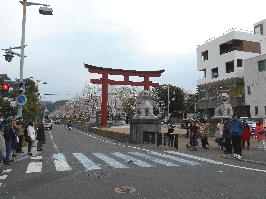
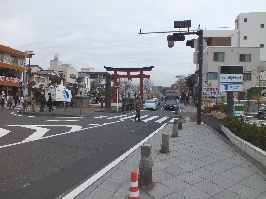
@@@Wakamiya-oji is a broad, straight avenue that runs north-south from the entrance to Hachimangu shrine towards Yuigahama Beach (RδKl).
@@@This street was built by order of Minamoto no Yoritomo (Ή©) to pray that his wife Masako (q) would give safe birth to a baby boy. Yoritomo already had a daughter, but he desired to have a boy, since only a male heir could become shogun. When Yoritomo learnt of his wifefs pregnancy, he immediately began the construction of an approach to the shrine, a plan he had been considering for some time. Wakamiya-oji is said to have been modeled on Suzaku-oji Street (ιεH) in Heiankyo (½ΐ), the capital in the Heian period. Hojo Tokimasa (kπ) and other retainers worked to complete it and Yoritomo himself had observed the construction work.
@@@Excavation has revealed that Wakamiya-oji was as wide as 33 meters in the early days.
Dankazura
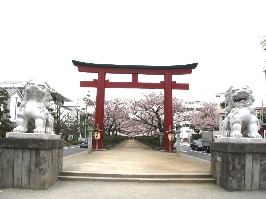
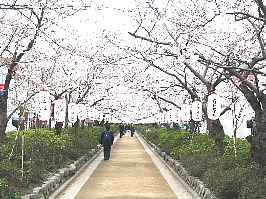
@@@This raised path becomes a beautiful avenue of cherry blossoms in the springtime. There are some three hundred trees along the pathway. They were first planted here in 1917, when the path underwent repairs. The original Dankazura was also built by the shogun Yoritomo, when Wakamiya-oji was constructed in the 12th century. It lies about two meters under your feet. The present path was built in the 16th century.
@@@The history of Dankazura is written on the stone tablet standing by the Ni-no-torii or Second Gate. It says that Yoritomo had the pathway built in 1182, to pray for the safe birth of his child. Many samurai of the Genji clan were involved in the construction.
@@@At that time, the raised pathway ran from the First Gate, near the beach, right up to the shrine, and was supported on either side with a wall of stacked stones.
@@@The gdanh of Dankazura means ga raised section,h while "kazura,h short of gkazurasishi,h means (square) stones that are laid out on the upper outer edge of a raised foundation or ground to prevent it from crumbling. Thus, Dankazura is a raised pathway rimmed with square stones on a broader street.
|
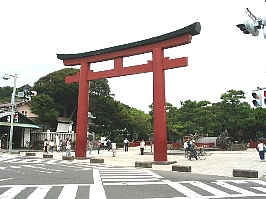 The imposing San no Torii, the Third Shrine Gate, stands at the entrance to Hachimangu Shrine. Every year, over 8 million visitors enter through this gate on their way to the Hachiman Shrine.
The imposing San no Torii, the Third Shrine Gate, stands at the entrance to Hachimangu Shrine. Every year, over 8 million visitors enter through this gate on their way to the Hachiman Shrine.
Minamoto no Yoriyoshi (Ή`,988-1075), an ancestor of Minamoto no Yoritomo (Ή©,1147-1199), built the first Tsurugaoka Hachiman Shrine nearer the sea, at Zaimokuza (ήΨΐ), in 1063 as a branch of the Iwashimizu Hachimangu Shrine (Ξ΄
ͺ¦{) in Kyoto.
One hundred and twenty years later, Yoritomo moved the shrine to this location, where it became an important place of worship for the warriors. Tsurugaoka Hachiman incorporated both Shinto and Buddhist beliefs and, until the Meiji Restoration, was known as the Tsurugaoka Hachiman Shrine and Temple.
|
|
Taikobashi Bridge(ΎΫ΄)
|
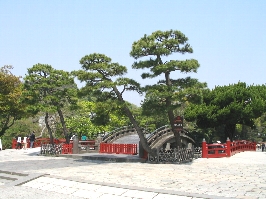
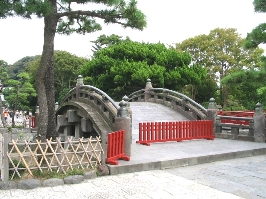
@@@Beyond the San no Torii Gate, is an arched stone bridge, called Taikobashi, literally, "Drum Bridge," spanning a channel that connects two ponds. The main shrine structure can be seen straight ahead on the hillside.
|
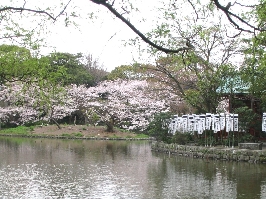
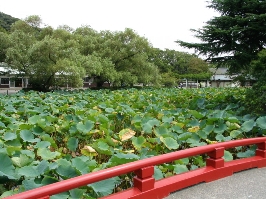
The origin of the two ponds dates back to 1182, when they were created on the order of Hojo Masako (kπq,1157-1225), the wife of Yoritomo. In the Genji Pond on the right, the lotus flowers are white, in honor of the Genji (Ή), in other words, the Minamoto clan, while the lotus in the Heike Pond on the left are red, the color of the Heike-the Taira clan (½). The Genji Pond has three islands which represent prosperity, while the Heike Pond has four islands, which represent death and destruction.
|
|
Hata-age Benzaiten (ψgΩΰV)
|
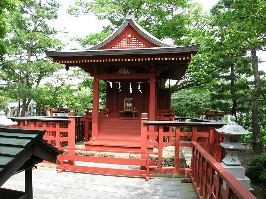 The Genji Ike Pond lies to the right and is the larger of the two lakes. It has three islands and white lotus flowers, which represent the Genji.
The Genji Ike Pond lies to the right and is the larger of the two lakes. It has three islands and white lotus flowers, which represent the Genji.
The shrine on the island is known as the Hata-age Benzaiten. "Hata-age" means raising the banner" and this shrine commerorates Yoritomo's raising of the Yoriyomo clan's white flag when it declared war on the Heike-the Taira clan.
|
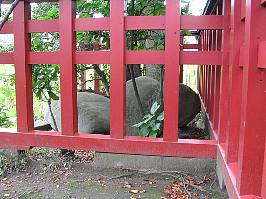 If you go around to the back of the shrine, you will come to two large rocks named after Masako, the wife of Yoritomo, the first shogun. The rocks have become symbols of a happily married couple.
If you go around to the back of the shrine, you will come to two large rocks named after Masako, the wife of Yoritomo, the first shogun. The rocks have become symbols of a happily married couple.
And if you look at the island in front of you, you will notice a great number of waterbirds. The two ponds are a testament to the rich natural environment of this area.
|
|
Yabusame-baba (¬Lnnκ)
|
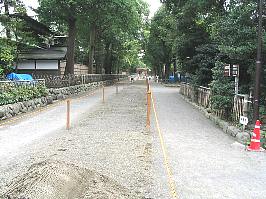 This track, which runs at right angles to the main approach, is where the yabusame archery contests are held every year in April and September. The archers, dressed as warriors of the Kamakura period, race at top speed on horseback along the 260-meter track and take aim at three targets set at 70-meter intervals-an amazing feat of both archery and horsemanship.
This track, which runs at right angles to the main approach, is where the yabusame archery contests are held every year in April and September. The archers, dressed as warriors of the Kamakura period, race at top speed on horseback along the 260-meter track and take aim at three targets set at 70-meter intervals-an amazing feat of both archery and horsemanship.
|
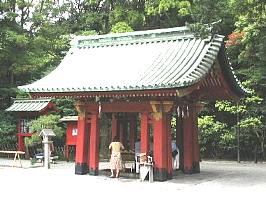 The red structure is where worshippers wash their hands and rinse their mouths to purify themselves before approaching the main shrine. The basin is carved out of a huge rock from the Bizen (υO) region of western Japan and was presented by the wife of Tokugawa Hidetada (ΏμG,1579-1632), the 2nd Tokugawa shogun (Ώμ«R), in the 17th century, after she saw a dream bidding her to do so. It is one of the few officially designated cultural treasures that the public are allowed to touch.
The red structure is where worshippers wash their hands and rinse their mouths to purify themselves before approaching the main shrine. The basin is carved out of a huge rock from the Bizen (υO) region of western Japan and was presented by the wife of Tokugawa Hidetada (ΏμG,1579-1632), the 2nd Tokugawa shogun (Ώμ«R), in the 17th century, after she saw a dream bidding her to do so. It is one of the few officially designated cultural treasures that the public are allowed to touch.
|
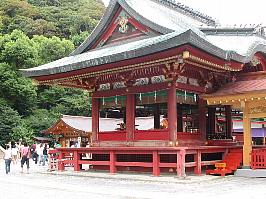
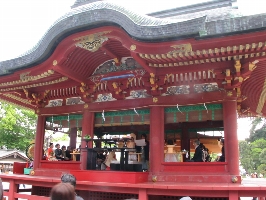
The raised stage at the center of the square is the Maiden. This is where ceremonies are held every year in April to commemorate a dance performed in 1186 by Shizuka (Γ,?-?), the mistress of the warrior Minamoto no Yoshitsune (Ή`o,1159-89). The original dance is said to have taken place in a corridor inside the shrine. Shizuka was being held captive after attempting to flee with Yoshitsune, who had fallen out with his brother, Yoritomo. Known as a skilled dancer, she was ordered to perform in front of Yoritomo and his wife Masako. It was a defiant dance in which she sang of her undying love for Yoshitsune.
These days, local musicians also perform here during the summer festival.
|
|
Giant gingko tree (εβΗ)
|
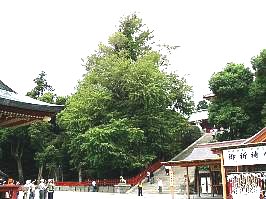 The huge tree on the left side of the main stairway is the famous gingko tree where a terrible assassination took place on January 27th, 1219. Just as Sanetomo, the third shogun, was walking down the steps after praying at the shrine, he was set upon by Kugyo (φΕ,1200-19), his nephew, who had hidden behind the tree. Kugyo was seeking his revenge, convinced that Sanetomo had been responsible for the death of his father.
The huge tree on the left side of the main stairway is the famous gingko tree where a terrible assassination took place on January 27th, 1219. Just as Sanetomo, the third shogun, was walking down the steps after praying at the shrine, he was set upon by Kugyo (φΕ,1200-19), his nephew, who had hidden behind the tree. Kugyo was seeking his revenge, convinced that Sanetomo had been responsible for the death of his father.
|
|
Hongu or Uenomiya ({{@Ν@γ{)
|
|
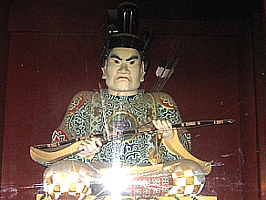
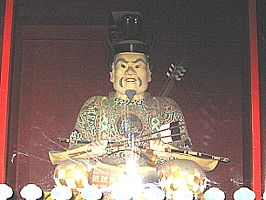
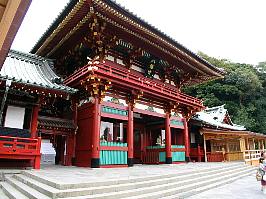
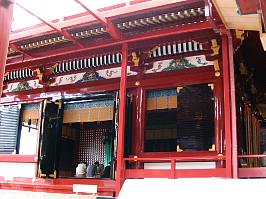
@@@The main hall of the Hachiman Shrine is known as Hongu or Uenomiya. The Hachiman Shrine was first built in Yuigahama, close to the beach, and then moved to where the Wakamiya or Shitanomiya now stands at the bottom of the stairway in 1180 by Yoritomo. That shrine burnt to the ground ten years later, so the main shrine was finally moved to its present position at the top of the stairs. The inscription on top of the gate reads gHachimangu,h with the character for ghachi (ͺ),h the number eight, in the form of two doves. These birds were adopted as the guardians of this shrine, and have remained so until this day.
|
The building to the left of the main hall houses the treasures owned by the Tsurugaoka Hachiman Shrine. The collection includes ancient sacred treasures, portable shrines and military equipment.
|
|
Maruyama-inari Shrine (ΫRξΧΠ)
|
|
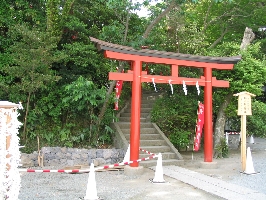
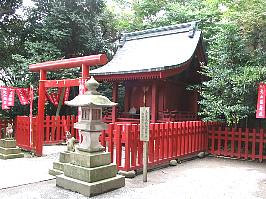
@@@The red structure on the raised ground to the left of the Main Hall is the Maruyama Inari Shrine. It is said to have stood originally at the site of the Main Hall, but was moved here in 1191 when the Main Hall itself was built in its present place. The roof and beams are in the style of the Muromachi period (Ί¬γ), which ran from the mid 14th to the mid 16th century. The shrine is dedicated to the god of business prosperity.
|
|
Wakamiya-sha or Shitanomiya (α{Π@Ν@Ί{)
|
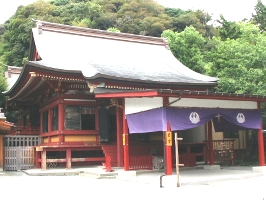
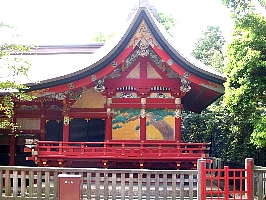
@@@This is the Wakamiya Shrine, also known as Shitanomiya. It is located in the exact spot where Yoritomo had the first Hachiman Shrine built. The present shrine was constructed by Hidetada and Iemitsu (ΏμΖυ, 1604-51), the 2nd and 3rd Tokugawa shogun, in the early 17th century. The splendid structure and elaborate carvings are similar to those of the Toshogu Shrine in Nikko.
|
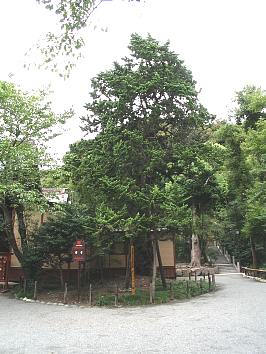 The tall trees on the right of the Wakamiya Shrine are byakushin or junipers. The saplings were imported from China by order of Sanetomo, the 2nd shogun, in the late 12th or early 13th century, and the trunks are now more than 4 meters in circumference. Another juniper stands close to the Taikobashi Bridge. This type of tree was usually planted within the grounds of temples, not shrines, so they are proof that Shintoism and Buddhism coexisted here in former times.
The tall trees on the right of the Wakamiya Shrine are byakushin or junipers. The saplings were imported from China by order of Sanetomo, the 2nd shogun, in the late 12th or early 13th century, and the trunks are now more than 4 meters in circumference. Another juniper stands close to the Taikobashi Bridge. This type of tree was usually planted within the grounds of temples, not shrines, so they are proof that Shintoism and Buddhism coexisted here in former times.
|
|
A Prayer Spot for Yui-wakamiya Shrine (Rδα{yq)
|
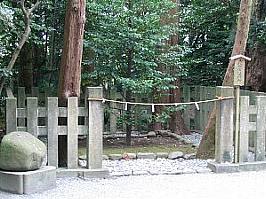 The original Hachiman Shrine stood nearer the sea at Zaimokuza. In the past, when people wanted to pay their respects at the Yui-wakamiya, as it was called then, they could do so from this point, rather than going all the way to the shrine itself.
The original Hachiman Shrine stood nearer the sea at Zaimokuza. In the past, when people wanted to pay their respects at the Yui-wakamiya, as it was called then, they could do so from this point, rather than going all the way to the shrine itself.
|
|
The Crane-Turtle Stone (ίTΞ)
|
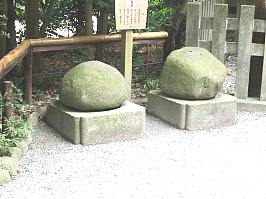 The images of two traditional symbols of good fortune - a crane and a turtle - are said to appear when you pour water over these stones.
The images of two traditional symbols of good fortune - a crane and a turtle - are said to appear when you pour water over these stones.
|
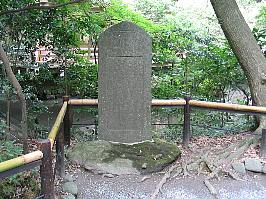 According to the explanation on the stone tablet nearby, this spot was well known for its weeping willow trees. An old poem tells of the young leaves of the willow, which used to announce the coming of spring.
According to the explanation on the stone tablet nearby, this spot was well known for its weeping willow trees. An old poem tells of the young leaves of the willow, which used to announce the coming of spring.
|
|
Shirahata Shrine (ψ_Π)
|
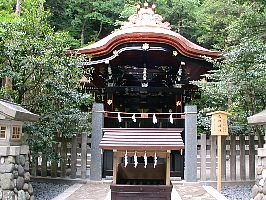
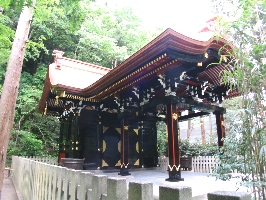
@@@The shrine building with black lacquered pillars and gold ornaments is the Shirahata Jinja. It is the guardian shrine of the Genji clan and you will come across many shrines with this name all over Japan.
This Shirahata or White Flag Shrine was built in the year 1200 and is dedicated to Minamoto no Yoritomo, the founder of the Kamakura shogunate, and his son, Sanetomo (Ήΐ©,1192-1219), the third shogun. The warlord Toyotomi Hideyoshi (LbGg,1537-1598) is said to have visited the shrine in 1590, and talked to the statue of Yoritomo and given it a friendly pat.
The statue has been designated an Important Cultural Property, and is now kept at the Tokyo National Museum in Ueno Park. The festival to honor Yoritomo at this shrine takes place on May 28th every year, while Sanetomo's day comes on August 9th. The present building was restored in 1897.
|
|
Kamakura National Treasure Museum (qσΩ)
|
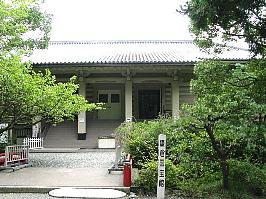 In the Great Kanto Earthquake of 1923, many of Kamakurafs shrines and temples suffered serious damage. In order to protect many treasures of this ancient capital from further damage, the people of Kamakura themselves donated the funds to build the Kamakura National Treasure Museum. It opened in 1928 and contains artifacts that have been designated National Treasures and Important Cultural Treasures.
In the Great Kanto Earthquake of 1923, many of Kamakurafs shrines and temples suffered serious damage. In order to protect many treasures of this ancient capital from further damage, the people of Kamakura themselves donated the funds to build the Kamakura National Treasure Museum. It opened in 1928 and contains artifacts that have been designated National Treasures and Important Cultural Treasures.
|
|
Saikan and Kihinkan Hall (ΦΩEMoΩ)
|
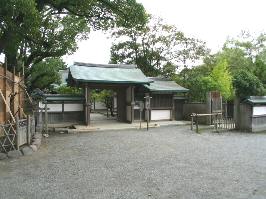 To the right of the torii gate on the eastern side is the guest house, where visitors to special ceremonies are welcomed and where the priests prepare for various festivals. The rooms can be seen from the Peony Garden.
To the right of the torii gate on the eastern side is the guest house, where visitors to special ceremonies are welcomed and where the priests prepare for various festivals. The rooms can be seen from the Peony Garden.
|
|
The Peony Garden (Ϊ½ρλ)
|
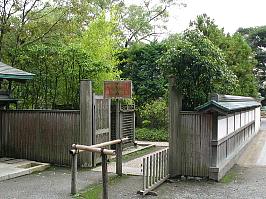 The peony garden by the Genpei Ponds was established to commemorate the 800th anniversary of the shrine. The inner garden is laid with pine moss brought from Kyoto and the rock garden was designed by a gardener from Chinafs Suzhou Province.
Winter peonies are on display from January to the end of February, while over 2,000 spring peonies can be viewed from mid-April to mid-May, and the wild hydrangeas are at their best in June.
The peony garden by the Genpei Ponds was established to commemorate the 800th anniversary of the shrine. The inner garden is laid with pine moss brought from Kyoto and the rock garden was designed by a gardener from Chinafs Suzhou Province.
Winter peonies are on display from January to the end of February, while over 2,000 spring peonies can be viewed from mid-April to mid-May, and the wild hydrangeas are at their best in June.
|
|
Sazare-ishi Stone (³΄κΞ)
|
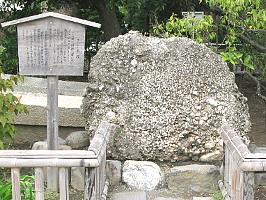 This boulder is made up of numerous pebbles-sazare ishi. Most Japanese are familiar with the word because it is mentioned in a phrase within the Kimigayo national anthem. The boulder came from Gifu Prefecture, where it was designated a precious natural treasure in 1977. Four years later, it was presented to Tsurugaoka Hachiman. The stone tablet behind the boulder is inscribed with the name of Sugawara Tsusai (΄ΚΦ), to honour his contribution to the prosperity of Kamakura in the early Showa period.
This boulder is made up of numerous pebbles-sazare ishi. Most Japanese are familiar with the word because it is mentioned in a phrase within the Kimigayo national anthem. The boulder came from Gifu Prefecture, where it was designated a precious natural treasure in 1977. Four years later, it was presented to Tsurugaoka Hachiman. The stone tablet behind the boulder is inscribed with the name of Sugawara Tsusai (΄ΚΦ), to honour his contribution to the prosperity of Kamakura in the early Showa period.
|
|
Kanagawa Prefectural Museum of Modern Art (_ήμίγόpΩ)
|
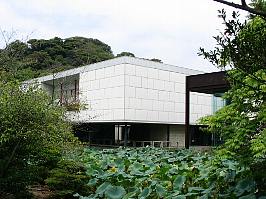 The Kanagawa Prefectural Museum of Modern Art opened in November 1951 and offers exhibitions of modern and contemporary art from Japan and around the world. The architect was Junzo Itakura. There is also an annex to the museum on the other side of the road.
The Kanagawa Prefectural Museum of Modern Art opened in November 1951 and offers exhibitions of modern and contemporary art from Japan and around the world. The architect was Junzo Itakura. There is also an annex to the museum on the other side of the road.
|
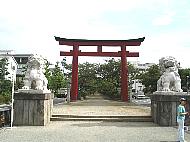
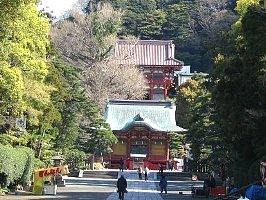
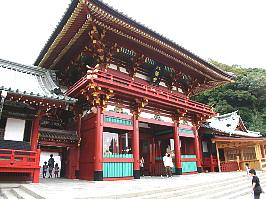




 The imposing San no Torii, the Third Shrine Gate, stands at the entrance to Hachimangu Shrine. Every year, over 8 million visitors enter through this gate on their way to the Hachiman Shrine.
The imposing San no Torii, the Third Shrine Gate, stands at the entrance to Hachimangu Shrine. Every year, over 8 million visitors enter through this gate on their way to the Hachiman Shrine.




 The Genji Ike Pond lies to the right and is the larger of the two lakes. It has three islands and white lotus flowers, which represent the Genji.
The Genji Ike Pond lies to the right and is the larger of the two lakes. It has three islands and white lotus flowers, which represent the Genji.
 If you go around to the back of the shrine, you will come to two large rocks named after Masako, the wife of Yoritomo, the first shogun. The rocks have become symbols of a happily married couple.
If you go around to the back of the shrine, you will come to two large rocks named after Masako, the wife of Yoritomo, the first shogun. The rocks have become symbols of a happily married couple.
 This track, which runs at right angles to the main approach, is where the yabusame archery contests are held every year in April and September. The archers, dressed as warriors of the Kamakura period, race at top speed on horseback along the 260-meter track and take aim at three targets set at 70-meter intervals-an amazing feat of both archery and horsemanship.
This track, which runs at right angles to the main approach, is where the yabusame archery contests are held every year in April and September. The archers, dressed as warriors of the Kamakura period, race at top speed on horseback along the 260-meter track and take aim at three targets set at 70-meter intervals-an amazing feat of both archery and horsemanship.
 The red structure is where worshippers wash their hands and rinse their mouths to purify themselves before approaching the main shrine. The basin is carved out of a huge rock from the Bizen (υO) region of western Japan and was presented by the wife of Tokugawa Hidetada (ΏμG,1579-1632), the 2nd Tokugawa shogun (Ώμ«R), in the 17th century, after she saw a dream bidding her to do so. It is one of the few officially designated cultural treasures that the public are allowed to touch.
The red structure is where worshippers wash their hands and rinse their mouths to purify themselves before approaching the main shrine. The basin is carved out of a huge rock from the Bizen (υO) region of western Japan and was presented by the wife of Tokugawa Hidetada (ΏμG,1579-1632), the 2nd Tokugawa shogun (Ώμ«R), in the 17th century, after she saw a dream bidding her to do so. It is one of the few officially designated cultural treasures that the public are allowed to touch.


 The huge tree on the left side of the main stairway is the famous gingko tree where a terrible assassination took place on January 27th, 1219. Just as Sanetomo, the third shogun, was walking down the steps after praying at the shrine, he was set upon by Kugyo (φΕ,1200-19), his nephew, who had hidden behind the tree. Kugyo was seeking his revenge, convinced that Sanetomo had been responsible for the death of his father.
The huge tree on the left side of the main stairway is the famous gingko tree where a terrible assassination took place on January 27th, 1219. Just as Sanetomo, the third shogun, was walking down the steps after praying at the shrine, he was set upon by Kugyo (φΕ,1200-19), his nephew, who had hidden behind the tree. Kugyo was seeking his revenge, convinced that Sanetomo had been responsible for the death of his father.








 The tall trees on the right of the Wakamiya Shrine are byakushin or junipers. The saplings were imported from China by order of Sanetomo, the 2nd shogun, in the late 12th or early 13th century, and the trunks are now more than 4 meters in circumference. Another juniper stands close to the Taikobashi Bridge. This type of tree was usually planted within the grounds of temples, not shrines, so they are proof that Shintoism and Buddhism coexisted here in former times.
The tall trees on the right of the Wakamiya Shrine are byakushin or junipers. The saplings were imported from China by order of Sanetomo, the 2nd shogun, in the late 12th or early 13th century, and the trunks are now more than 4 meters in circumference. Another juniper stands close to the Taikobashi Bridge. This type of tree was usually planted within the grounds of temples, not shrines, so they are proof that Shintoism and Buddhism coexisted here in former times.
 The original Hachiman Shrine stood nearer the sea at Zaimokuza. In the past, when people wanted to pay their respects at the Yui-wakamiya, as it was called then, they could do so from this point, rather than going all the way to the shrine itself.
The original Hachiman Shrine stood nearer the sea at Zaimokuza. In the past, when people wanted to pay their respects at the Yui-wakamiya, as it was called then, they could do so from this point, rather than going all the way to the shrine itself.
 The images of two traditional symbols of good fortune - a crane and a turtle - are said to appear when you pour water over these stones.
The images of two traditional symbols of good fortune - a crane and a turtle - are said to appear when you pour water over these stones.
 According to the explanation on the stone tablet nearby, this spot was well known for its weeping willow trees. An old poem tells of the young leaves of the willow, which used to announce the coming of spring.
According to the explanation on the stone tablet nearby, this spot was well known for its weeping willow trees. An old poem tells of the young leaves of the willow, which used to announce the coming of spring.


 In the Great Kanto Earthquake of 1923, many of Kamakurafs shrines and temples suffered serious damage. In order to protect many treasures of this ancient capital from further damage, the people of Kamakura themselves donated the funds to build the Kamakura National Treasure Museum. It opened in 1928 and contains artifacts that have been designated National Treasures and Important Cultural Treasures.
In the Great Kanto Earthquake of 1923, many of Kamakurafs shrines and temples suffered serious damage. In order to protect many treasures of this ancient capital from further damage, the people of Kamakura themselves donated the funds to build the Kamakura National Treasure Museum. It opened in 1928 and contains artifacts that have been designated National Treasures and Important Cultural Treasures.
 To the right of the torii gate on the eastern side is the guest house, where visitors to special ceremonies are welcomed and where the priests prepare for various festivals. The rooms can be seen from the Peony Garden.
To the right of the torii gate on the eastern side is the guest house, where visitors to special ceremonies are welcomed and where the priests prepare for various festivals. The rooms can be seen from the Peony Garden.
 The peony garden by the Genpei Ponds was established to commemorate the 800th anniversary of the shrine. The inner garden is laid with pine moss brought from Kyoto and the rock garden was designed by a gardener from Chinafs Suzhou Province.
Winter peonies are on display from January to the end of February, while over 2,000 spring peonies can be viewed from mid-April to mid-May, and the wild hydrangeas are at their best in June.
The peony garden by the Genpei Ponds was established to commemorate the 800th anniversary of the shrine. The inner garden is laid with pine moss brought from Kyoto and the rock garden was designed by a gardener from Chinafs Suzhou Province.
Winter peonies are on display from January to the end of February, while over 2,000 spring peonies can be viewed from mid-April to mid-May, and the wild hydrangeas are at their best in June.
 This boulder is made up of numerous pebbles-sazare ishi. Most Japanese are familiar with the word because it is mentioned in a phrase within the Kimigayo national anthem. The boulder came from Gifu Prefecture, where it was designated a precious natural treasure in 1977. Four years later, it was presented to Tsurugaoka Hachiman. The stone tablet behind the boulder is inscribed with the name of Sugawara Tsusai (΄ΚΦ), to honour his contribution to the prosperity of Kamakura in the early Showa period.
This boulder is made up of numerous pebbles-sazare ishi. Most Japanese are familiar with the word because it is mentioned in a phrase within the Kimigayo national anthem. The boulder came from Gifu Prefecture, where it was designated a precious natural treasure in 1977. Four years later, it was presented to Tsurugaoka Hachiman. The stone tablet behind the boulder is inscribed with the name of Sugawara Tsusai (΄ΚΦ), to honour his contribution to the prosperity of Kamakura in the early Showa period.
 The Kanagawa Prefectural Museum of Modern Art opened in November 1951 and offers exhibitions of modern and contemporary art from Japan and around the world. The architect was Junzo Itakura. There is also an annex to the museum on the other side of the road.
The Kanagawa Prefectural Museum of Modern Art opened in November 1951 and offers exhibitions of modern and contemporary art from Japan and around the world. The architect was Junzo Itakura. There is also an annex to the museum on the other side of the road.